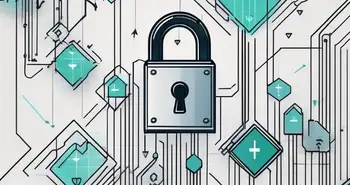Blockchain Scaling Explained

Blockchain scaling is a critical topic in the world of cryptocurrencies. As more and more transactions are processed on blockchain networks, it becomes crucial to ensure that these networks can handle the increasing load effectively. In this ultimate guide, I will break down the concept of blockchain scaling, discuss its importance, explore different approaches to scaling, highlight the challenges involved, and take a glimpse into the future of blockchain scaling.
Understanding Blockchain Scaling
Before diving into the intricacies of blockchain scaling, let's first establish a solid understanding of the basics of blockchain. At its core, blockchain is a decentralized and immutable digital ledger that records transactions across multiple computers. This technology gained popularity with the rise of cryptocurrencies like Bitcoin.
Blockchain scaling, as the term suggests, revolves around making improvements to the blockchain network so that it can handle a larger volume of transactions in a more efficient manner. It aims to overcome the limitations that arise as more users participate in the network and the number of transactions increases exponentially.
One of the key challenges in blockchain scaling is achieving consensus among the network participants. Consensus mechanisms like Proof of Work (PoW) and Proof of Stake (PoS) play a crucial role in ensuring that all nodes in the network agree on the validity of transactions. However, as the network grows, achieving consensus becomes more complex and time-consuming.
Another aspect of blockchain scaling is the issue of network congestion. As more transactions are added to the blockchain, the network can become congested, leading to delays and increased transaction fees. This has been a significant hurdle for popular blockchain networks like Ethereum, prompting developers to explore solutions such as sharding and layer 2 scaling solutions.
The Importance of Blockchain Scaling
Efficient blockchain scaling is crucial for the widespread adoption of cryptocurrencies as a medium of exchange. If a blockchain network cannot keep up with the growing demand, it may result in slow transaction speeds and higher costs. And nobody wants to wait for hours to confirm their transaction or pay exorbitant fees, right?
Blockchain scaling is a complex and dynamic process that involves finding innovative solutions to increase the capacity and efficiency of blockchain networks. It requires collaboration among developers, miners, and users to implement changes that can accommodate the expanding user base and transaction volume.
Enhancing Transaction Speed
One of the primary goals of blockchain scaling is to enhance transaction speed. Traditional blockchain networks, such as Bitcoin, have limitations in terms of the number of transactions they can process per second. By implementing scaling solutions, we can significantly increase the transaction throughput, making blockchain more user-friendly and practical for everyday transactions.
Improving transaction speed not only benefits individual users but also opens up new possibilities for businesses and industries looking to leverage blockchain technology for various applications. From supply chain management to digital identity verification, faster transaction speeds enable real-time processing and seamless integration of blockchain into existing systems.
Reducing Transaction Costs
Blockchain scaling can also help reduce transaction costs. High fees associated with some blockchain networks have often been a subject of criticism. By enabling more efficient scaling mechanisms, we can bring down the costs, making blockchain-based transactions more affordable and accessible to a broader audience.
Lower transaction costs not only make cryptocurrencies more attractive for everyday use but also pave the way for microtransactions and new business models that were previously impractical due to high fees. This shift towards lower costs and increased efficiency can drive innovation and foster the development of a more inclusive and sustainable blockchain ecosystem.
Different Approaches to Blockchain Scaling
There are two primary approaches to blockchain scaling: on-chain scaling solutions and off-chain scaling solutions.
Blockchain scaling is a crucial topic in the world of cryptocurrencies, as it directly impacts the speed and cost of transactions. By exploring different scaling solutions, developers aim to enhance the efficiency and scalability of blockchain networks to accommodate a growing user base and increasing transaction volumes.
On-Chain Scaling Solutions
On-chain scaling refers to making adjustments directly within the blockchain protocol to increase its capacity to process transactions. One popular on-chain scaling solution is increasing the block size limit, which allows more transactions to be included in each block. However, this approach can lead to centralization concerns, as larger blocks require more storage and bandwidth, making it difficult for average users to participate fully.
Another on-chain scaling approach involves implementing sharding, which divides the blockchain into smaller parts called shards to process transactions in parallel. Sharding can significantly improve scalability by distributing the workload across multiple nodes, but it requires complex consensus mechanisms to maintain network security and integrity.
Off-Chain Scaling Solutions
Off-chain scaling solutions aim to move some of the transactions off the main blockchain, reducing the load on the network. Techniques such as payment channels and sidechains enable users to conduct transactions without burdening the main network. While off-chain scaling can improve scalability, it requires additional infrastructure and introduces complexities.
Another off-chain scaling solution gaining traction is the implementation of state channels, which allow users to interact and transact off-chain while retaining the security guarantees of the main blockchain. State channels enable instant micropayments and reduce the need for every transaction to be recorded on the main chain, enhancing scalability and speed.
The Challenges of Blockchain Scaling
While blockchain scaling is essential, it comes with its fair share of challenges.
Blockchain scaling is a critical issue that has been at the forefront of discussions within the cryptocurrency community. As the number of transactions on a blockchain network grows, the need for scalability becomes increasingly apparent. Without effective scaling solutions, blockchain networks can become congested, leading to slow transaction speeds and high fees.
Security Concerns
Implementing scaling solutions must be done with utmost care to maintain the security and integrity of the blockchain. Any changes made to the protocol can potentially introduce vulnerabilities, making the network susceptible to attacks. Striking the right balance between scalability and security is a delicate task.
Security concerns in blockchain scaling are multifaceted. Not only do developers need to ensure that the network remains resilient against external threats, but they also need to consider the implications of any changes on the existing consensus mechanisms. A misstep in implementing scaling solutions could have far-reaching consequences, jeopardizing the trust that users have in the network.
Decentralization Dilemma
Blockchain networks are built on the principles of decentralization and trustlessness. However, some scaling solutions may compromise these core values. For instance, increasing the block size limit might make it difficult for average users to participate in the network, leading to a more centralized ecosystem. It is crucial to find scalable solutions that preserve the essence of decentralization.
The decentralization dilemma in blockchain scaling is a complex issue that requires careful consideration. While increasing block sizes or implementing off-chain solutions may improve scalability, they could also inadvertently centralize control in the hands of a few powerful entities. Striking a balance between scalability and decentralization is essential to ensure that blockchain networks remain inclusive and resilient in the face of evolving challenges.
Future of Blockchain Scaling
The future of blockchain scaling looks promising, with various scaling solutions being explored.
Emerging Scaling Solutions
Developers and researchers are actively working on innovative scaling solutions such as sharding and state channels. Sharding involves dividing the blockchain into smaller parts, allowing parallel processing of transactions. State channels, on the other hand, enable off-chain transactions while ensuring the validity and integrity of the blockchain. These solutions show great potential in addressing scalability concerns.
The Role of Blockchain Scaling in Crypto Adoption
Blockchain scaling plays a vital role in the mainstream adoption of cryptocurrencies. Only when blockchain networks can handle a significant number of transactions quickly and at low costs can cryptocurrencies become a feasible alternative to traditional payment systems. Scaling solutions pave the way for wider acceptance and usage of cryptocurrencies in various industries.
Personal Advice: As an expert in blockchain scaling, I have witnessed the evolution of this technology firsthand. While it is crucial to pursue scaling solutions, it is equally important to stay mindful of the security and decentralization aspects. We must strike a balance between scalability and preserving the fundamental values that make blockchain revolutionary.
FAQ
What is blockchain scaling?
Blockchain scaling refers to the process of improving the capacity and efficiency of a blockchain network to handle a larger volume of transactions.
Why is blockchain scaling important?
Efficient scaling is crucial for widespread adoption as it enhances transaction speed and reduces costs, making blockchain-based transactions more user-friendly.
What are the different approaches to blockchain scaling?
There are two primary approaches to blockchain scaling: on-chain scaling solutions, which make adjustments within the blockchain protocol, and off-chain scaling solutions, which move some transactions off the main blockchain.
What are the challenges of blockchain scaling?
Blockchain scaling presents challenges such as security concerns and the potential compromise of decentralization principles.
What does the future hold for blockchain scaling?
The future of blockchain scaling looks promising with emerging solutions such as sharding and state channels, which have the potential to address scalability concerns and foster wider crypto adoption.
As an expert in blockchain scaling, I am thrilled to see the progress being made in this space. It is clear that blockchain scaling is a significant focus for developers, researchers, and industry players alike. With innovative solutions and careful considerations, we can pave the way for robust and scalable blockchain networks that will shape the future of finance and beyond.
As blockchain scaling continues to evolve, so does the opportunity for innovative trading platforms like Morpher to revolutionize the investment landscape. Morpher's unique platform, built on the Ethereum blockchain, aligns perfectly with the advancements in blockchain scalability discussed in this guide. With zero fees, infinite liquidity, and the ability to trade across a multitude of asset classes, Morpher is designed for the future of investing. Whether you're interested in traditional markets or exploring new frontiers like NFTs, Morpher offers a seamless and secure trading experience. Ready to be part of the future? Sign Up and Get Your Free Sign Up Bonus today and join the trading revolution with Morpher.

Disclaimer: All investments involve risk, and the past performance of a security, industry, sector, market, financial product, trading strategy, or individual’s trading does not guarantee future results or returns. Investors are fully responsible for any investment decisions they make. Such decisions should be based solely on an evaluation of their financial circumstances, investment objectives, risk tolerance, and liquidity needs. This post does not constitute investment advice.

Painless trading for everyone
Hundreds of markets all in one place - Apple, Bitcoin, Gold, Watches, NFTs, Sneakers and so much more.

Painless trading for everyone
Hundreds of markets all in one place - Apple, Bitcoin, Gold, Watches, NFTs, Sneakers and so much more.









